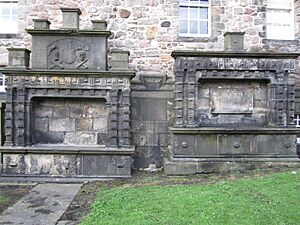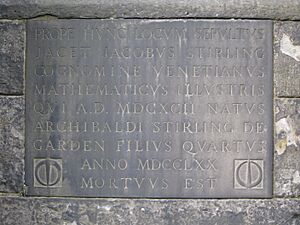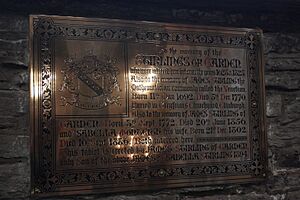James Stirling (mathematician) facts for kids
Quick facts for kids
James Stirling
|
|
|---|---|
| Born | 11 May O.S. 1692 Garden, Stirlingshire
|
| Died | 5 December 1770 (aged 78) |
| Resting place | Greyfriars Kirkyard |
| Nationality | Scottish |
| Known for |
|
| Scientific career | |
| Fields | |
James Stirling was a very clever Scottish mathematician. He was born on May 11, 1692, in a place called Garden, in Stirlingshire. He lived until December 5, 1770. People sometimes called him "The Venetian."
Many important math ideas are named after him. These include the Stirling numbers and Stirling's approximation. He also helped prove that Isaac Newton's ideas about cubic plane curves were correct.
About James Stirling



James Stirling was born on May 11, 1692. His family lived at Garden House, near Stirling, Scotland. He was the third son of Archibald Stirling.
When James was 18, he went to Oxford University. He received a special scholarship there. However, in 1715, he was asked to leave the university. This happened because he was writing letters to his cousins. His cousins were known as Jacobites, who supported the old royal family.
Time in Venice
After leaving Oxford, James Stirling traveled to Venice, Italy. While he was there, he worked as a math professor. In 1717, he published his first book about math.
He also sent a paper to the Royal Society in London. This paper was about a math method by Isaac Newton. James Stirling later had to leave Venice. He was afraid someone might hurt him because he had learned a secret from glassmakers there. With help from Isaac Newton, he returned to London around 1725.
Working in London
James Stirling stayed in London for about ten years. He worked at a special school and spent his free time on math. He also wrote letters to other famous mathematicians.
In 1730, he published his most important book. It was called Methodus differentialis. This book was a bigger version of the paper he sent to the Royal Society earlier. In 1735, he wrote another paper for the Royal Society. This one was about the shape of the Earth and how gravity changes on its surface.
Practical Work
In 1735, James Stirling became a manager for the Scots Mining Company in Leadhills. A house was even built for him there in 1736. He also wrote a paper about a special machine called a trompe. This machine used water power to push air. It was used in a Scottish lead mine.
Stirling also helped with a very big project in Glasgow. In 1752, the city of Glasgow gave him a silver tea-kettle. This was to thank him for his hard work. He had helped survey the River Clyde to make it deeper for ships. This was the first step in making Glasgow a major seaport!
Later, new versions of his books were published. Many of his old papers, letters, and notes are still kept at Garden House today.

